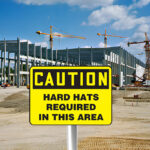You can use signs for such a wide array of purposes from advertising to conveying safety information. However, no matter how you use these products, certain features are almost universal among all the types.
These are the crucial aspects that signage needs to make it a success. You can arrange these in a variety of ways to suit your sign’s specific purpose.
Let’s look at six elements that you need to include on your signs. Together with this, we will cover a few more bonus tips for designing effective signage.
1- Text
The primary purpose of any sign is to communicate information to its audience. This is what makes it such a powerful tool in the hands of any business owner.
But how do you get this message across?
Yes, images can convey certain messages. But oftentimes, not as clearly as you can with words. It is up to a certain amount of interpretation. Therefore, the meaning an image conveys can be pretty ambiguous.
This is where using text comes in. Here are several reasons why words can be the ideal solution:
First, writing can help you to achieve the goal of the specific sign. What do you want to accomplish? Do you want to sell a particular product? Are you promoting a charity or cause? Use words when advertising something or describing something.
Second, you can use words to share crucial information about your business, like its name.
Third, you will often have to use text to communicate some terms and conditions or disclaimers.
The following are principles which you need to consider when it comes to text:
- Font: You need to choose the font carefully. Don’t choose one that is ornamental nor one that is too thin.
- Size: The text should be large enough that people will be able to read it from the relative distance.
- Amount: Keep it short and sweet. People are much more likely to read and remember a sign with fewer words.
- Complexity: Keep it simple. Go for clarity above anything else. Don’t use too many long and complicated words.
- Readability: All of these aspects boil down to how legible the words will be. There is no point to putting text on your size if people won’t be able to read it for any one of these reasons.
2- Graphics
Even though, the script is the key to conveying specific information clearly and unambiguously don’t discount images. Big or small, graphics are still an essential element of signs. It’s no wonder that most signs, whatever their goal, feature graphics of some kind or other.
Images are clearly the main alternative to communicating a message without any words. They are often the element that takes up the most space of any feature on the sign.
One critical use of images in advertising is to create an emotional appeal. This is key if you are trying to persuade an audience to take a particular action. Photographs often work best in this regard.
Graphics not only make a sign more interesting to look at but can also make it more memorable. All of this can help you to achieve your specific goals.
Obviously, some signs are limited in what they can include on them like our channel letters. But for graphics specific promo merchandise, you can get creative.

Another way in which graphics are used on signs is through symbols. Symbols are a mark or character used as a conventional representation of an object, function, or process. So these are images whose meaning will be recognized by most people.
Therefore, they are most often used on safety and warning signs like exclamation marks and also on directional signs like with arrows.
Whatever image you go with, try to make it as impactful as possible. You probably only have one chance to catch a person’s attention.
3- Branding
A third critical element on most types of signs is some form of branding.
But what exactly are we talking about here?
Branding is a practice through which a business creates a design, symbol or name that is easily identifiable as theirs. This is essential to help the audience recognize the company or other venture to which it is relevant.
People usually won’t have time to read your entire sign. So it’s better to play smart and make sure that the significant parts, like who your company is, are noticeable.
Here are ways you can incorporate branding on a sign:
- Logo: If your company has a well-established logo this should feature somewhere on your signage.
- Name: Otherwise, you could print your venture’s name somewhere on it. It should be legible. You don’t have to use both if one would be enough to tell people whose sign it is.
- Colors: Does your brand have a specific color palette? If so, it can be a good idea to incorporate this on the sign.
- Motto: A tagline can make your business much more memorable as long as it is catchy. If it fits the purpose of the sign, you could incorporate it too.
The board doesn’t have to be covered with features of your brand, but it should be noticeable.
Remember that your brand identity will be more effective if it is consistent. For this reason, you should keep it recognizable across all your platforms.
However, this aspect isn’t necessary for all signage. For example, there is typically no reason for a safety sign to show off a brand. As a matter of fact, many informational and directional signs won’t need to be branded.
4- Color
Few things in the world can have such a powerful effect on our minds as color can. It can be challenging to imagine signs without it. Even if you make your signage black and white, it is still an important feature to consider.
Color is a brilliant way to catch people’s attention. Bright and bold shades can help you make sure your sign stands out from its environment.
Additionally, you can use color to make small parts of the sign more visible. It can literally be the best highlighting tool. You can emphasize the most essential elements of the product by printing it in a different color or one that contrasts with its background.
Most of this boils down to creating the right aesthetic for your sign. You want to use the palette to your advantage to make it as appealing and impactful as possible.

Besides all of this, one of the most impactful uses of color is how you can employ it to affect your audience’s mood. You want to pick a palette that will evoke the right emotion and associations in people.
For instance, if you are making a sign to advertise a beach resort, you don’t want to coat it in red. Instead, use blue which can have a calming effect.
To use this effectively, you should learn as much as you can about the psychology of color.
5- Call to action
What is the point of designing and printing a sign if it doesn’t create the desired effect?
All types of signs are made to lead its audience to one action or another. Designers create advertisements to persuade people to buy a product or service from your company. These type of persuasive signs are probably the most flashy and exciting of all the signage products.
Not so differently, safety and warning signs are there to stop people from doing something that can harm them or others. And so forth.
No matter the sign, this is where the call to action comes in. This is any device which is used to prompt a response in the audience.
Nowadays, you will usually hear the term used to talk about digital sales and marketing. However, it is just as crucial in printed media.
A call to action should clearly tell the audience what you want them to do. It can be just a few words or a few sentences, but it should contain a verb of some kind. Words that you can use are:
- Buy
- Hire
- Call
- Click
- Donate
- Visit
- Share
- Register
These can work on both digital and printed signs.
Here are easy techniques you can use to make it more impactful:
- Create a sense of urgency. People are more likely to act if they feel they only have a short time to do so. That’s why limited offers and sales are so popular.
- Tell them what they will gain by taking action. Happiness? Excitement? Knowledge?
- You can make your call to action much more successful by using emotional appeal to persuade your audience.
For some inspiration, take a look at these brilliant examples of digital CTA’s. See for yourself just how effective they can be.
6- Interactive elements
Nowadays, another fantastic feature that you can include on your signage is interactive elements. These are devices that allow your audience to interact with the product physically. This adds a whole new level of depth to the experience.
Today, interactive features are one of the hottest tools in the industry. And for a good reason.
Research has shown that using them can lead to significant results. For example, the duration which a video holds your attention is increased by a whopping 47% when you add interactive elements.
What else do they bring to the table?

- They’re great at grabbing people’s attention. Besides this, it keeps your audience interested for longer.
- You don’t get much more memorable than interactive ads. The more time people spend with a sign, the more likely they are to recall it and your business later on.
- If you use them right, interactive elements can make your signage fabulously fun and exciting. Overall, this means that people are more likely to build positive associations with your brand.
- In digital products, you can use interactive features like a call to action. This can significantly boost responses to your ads.
Once again, this device can work wonders in both digital and printed signage.
You can make digital products interactive by adding links through buttons to creating virtual signs like banners. But this is only one potential application among many. The sky’s the limit to what you can do.
You also have more than one option when it comes to printed media. For example, an easy way you can implement this is to make signs that encourage people to take photos with it – like large frames. Another is to print QR codes on your sign that people can scan in order to find a link to your app.
Other tips to designing signs and their layout
But it’s not enough to simply throw all these elements together. Here are some pro tips on the design and layout of both your digital and physical signs:
- Save space: Don’t overwhelm your audience with new input. You really don’t have to fill every inch of your sign. Instead, stick to the essentials. Focus on making the critical message come across.
- Top to bottom and left to right: This is how we read, so it makes sense that the layout of your sign should match this style. Our eyes are trained to move this way. Therefore, you need to keep this in mind when planning the flow of the sign.
- Focal point: Successful signs usually have one primary central point. This can help you to grab people’s attention. Experts use lines to lead your eye to this center. On top of this, they use contrasting colors to highlight the point.
Holistic design
Intelligent design is becoming increasingly important in the modern world. The more saturated our environment’s become, the harder it can be to create a sign that will catch people’s eye. It’s all about putting the elements together to form a complete picture.
For more information read our article on the importance of good signage and the psychology behind how it works. And if you are having trouble choosing the right products perhaps take a look at the comprehensive guide to the different types of signs and their uses.




